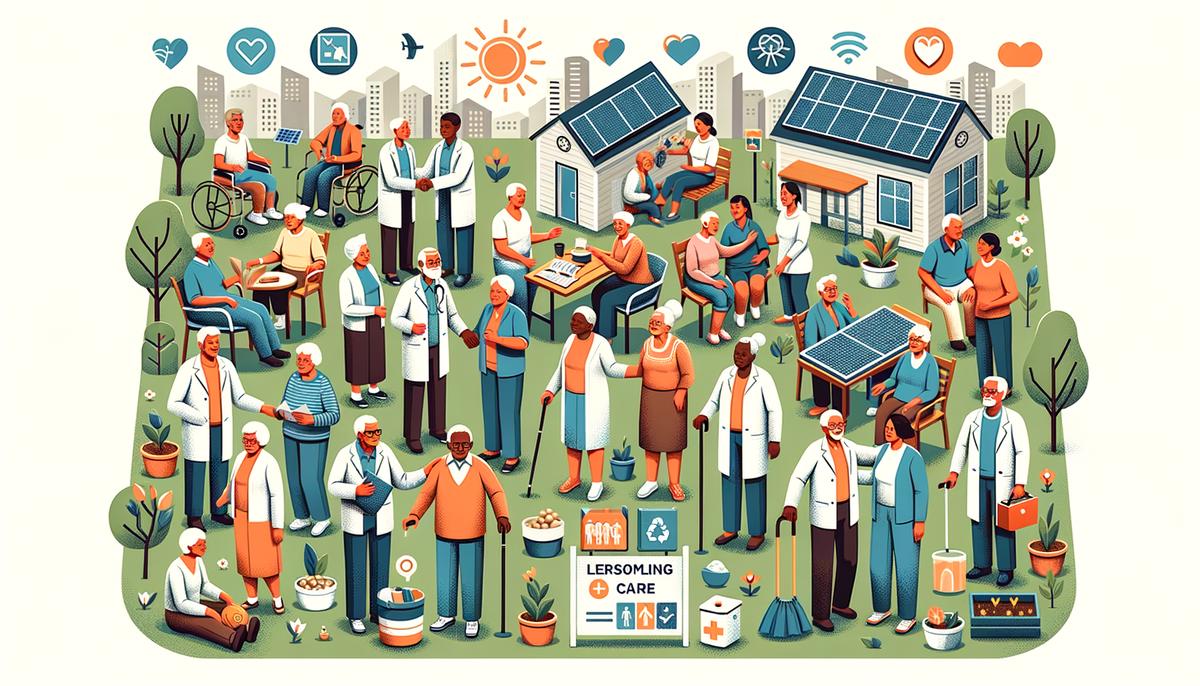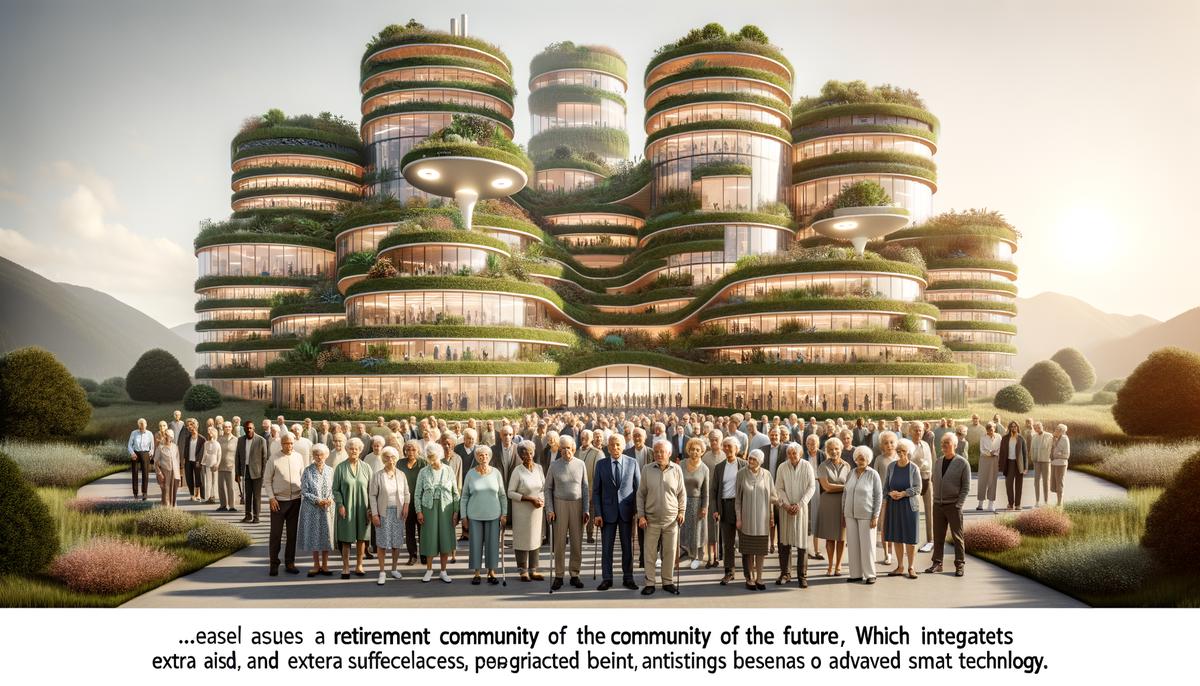The journey through life brings us to various milestones, with retirement being a significant one that many look forward to. This phase offers a new chapter where the focus shifts from work to enjoying the fruits of one’s labor in comfort and community. The development of retirement communities has played a pivotal role in shaping this chapter, providing environments that cater to the diverse needs and preferences of retirees. As we examine the evolution of these communities, we gain insight into how they have adapted to meet the changing desires of their residents, ensuring a blend of care, convenience, and quality of life.
Historical Beginnings of Retirement Communities
The concept of retirement communities traces back to the 20th century, rooted in significant societal changes. Before their inception, the elderly often lived out their golden years in the homes of family members. But as industrialization picked up speed, younger generations moved into cities leaving many elderly behind in rural areas. This shift began to strain traditional family support structures.
Parallel to these changes, advancements in healthcare significantly increased life expectancy. Suddenly, there was a growing segment of the population that lived longer but also required special care and social arrangements in their later years. This demographic shift prompted the need for a new solution for elder care.
In response, the first retirement community, touted as a haven for the retired to spend their leisure years, was created in Arizona in the 1950s. Named Sun City, it was a groundbreaking project launched by developer Del Webb. This community was designed to offer a vibrant, active lifestyle for retirees, featuring amenities like golf courses, swimming pools, and clubhouses.
Sun City set the blueprint for modern retirement communities. These establishments were no longer just about providing care; they were about enhancing the quality of life for retirees, enabling them to live independently while also having access to healthcare and social activities catered to their needs. They were constructed with the idea of community at their core—allowing residents to forge new friendships and find support among peers.
The initial success of projects like Sun City sparked a wave of retirement community developments across the United States. Each was designed with careful consideration for the lifestyle wants and health needs of retirees, blending liveability with care and convenience in a way that transformed how society approached aging.
As the concept evolved, so did the variety of communities available, ranging from active lifestyle complexes to assisted living and continuing care communities that could offer more comprehensive medical and personal care services.
With historical roots in responding to significant changes in family structure and life expectancy, today’s retirement communities owe much to early models like Sun City. These communities not only cater to the needs and desires of older adults but also stand as a testament to changing attitudes towards aging—highlighting an ongoing commitment to improving the quality of life for retirees through innovation and thoughtful design.

Shifts in Design and Amenities
Transitioning from basic housing and medical facilities, modern retirement communities have reshaped their architecture to mirror resort-style living. Structures and spaces are now designed to be more vibrant and visually appealing, moving away from the sterile and institutionalized aesthetics of the past. Wide windows, open floor plans, and natural lighting are integral, fostering an atmosphere of warmth and inclusivity.
- The integration of indoor and outdoor spaces has become a norm. Gardens, walking trails, and outdoor seating areas encourage residents to connect with nature and each other, enhancing their physical and mental well-being. These spaces not only serve aesthetic purposes but are functional, accessible areas where residents can practice gardening, exercise, or enjoy social gatherings.
- Wellness centers embody a shift towards holistic health, offering not just exercise equipment but also spaces for yoga, meditation, and aquatic therapy. The focus has broadened from physical fitness to encompass emotional and mental health, acknowledging the interconnectedness of different aspects of wellness.
- Memory care units have been another significant addition, designed specifically for residents with Alzheimer’s disease and other forms of dementia. These units are equipped with safety features and designed using cues to help residents navigate the space easily. Programs and activities are tailored to support cognitive function and provide a sense of routine and security.
- Gourmet dining options reflect a move towards sophisticated palates, with offerings that rival fine dining establishments. Nutritionally balanced menus, often crafted with input from dietitians and chefs, cater to diverse dietary needs and preferences. Open dining areas encourage social interaction, making meals a communal experience.
- Educational classes and workshops have become a staple, addressing the intellectual curiosity of residents. From art and computer classes to guest lectures on various topics, these programs provide opportunities for lifelong learning and cognitive engagement.
- Cultural excursions are organized to offer residents enriching experiences outside the community. Visits to theaters, museums, and cultural festivals keep them connected with the broader community, ensuring a vibrant social life.
This transformation in the physical and operational makeup of retirement communities subtly reflects broader trends in senior living, emphasizing autonomy, wellness, and enriched living experiences. As societal views on aging continue to evolve, so too do the environments designed to support this phase of life.

Adapting to Changing Resident Needs
Retirement communities have been quick to recognize the importance of personalized care, focusing on adapting to each resident’s unique health requirements. This has led to the development of customizable care plans that account for both medical and lifestyle needs, ensuring residents receive the precise support and healthcare monitoring they need to live comfortably and healthily.
Technological integration into these communities has taken several forms, from wearable devices that monitor vital signs to applications that facilitate communication with healthcare providers and family members. This technology not only helps keep residents safe by providing real-time health data but also allows them to stay connected with loved ones, fostering feelings of belonging and reducing isolation.
Social connection is a cornerstone of mental and emotional well-being. Retirement communities are responding by innovating their program offerings to foster a sense of community. This includes clubs and groups based on interests—ranging from literature to gardening—events, and social gatherings. Some communities have also integrated intergenerational programs, inviting students and young people to participate in activities, building bridges between generations and enriching the lives of all participants.
Lifelong learning opportunities are another area of growth, with communities offering classes and workshops on everything from art and photography to history and computer skills. This not only keeps the residents’ minds active but also allows them to explore new hobbies or deepen existing passions, contributing to a fulfilling lifestyle.
The fulfillment of emotional needs through methods such as pet therapy programs and buddy systems for new residents helps in easing the transition into community living, ensuring newcomers feel welcomed, valued, and quickly at home in their new environment.
In catering to the evolving desires of retirees, retirement communities have begun to emphasize outdoor recreational amenities more than ever. Facilities such as walking tracks, gardening areas, and golf courses allow residents to engage with nature and exercise in a pleasant environment, promoting physical well-being alongside mental relaxation.
Environmental sustainability has also become a priority, with many communities adopting green practices like solar energy, water conservation, and waste reduction programs. This not only benefits the planet but resonates with environmentally conscious residents who wish to live in harmony with their values.
In summary, by tailoring their care, integrating technology, fostering social connections, and prioritizing both environmental sustainability and lifelong learning, retirement communities are successfully adapting to meet the changing needs and preferences of their residents. Through innovative practices and focused attention on the individuals they serve, these communities are setting new standards for supportive, enriching retirement living.

The Future of Retirement Communities
The future of retirement communities is seeing a vibrant shift towards green living, prioritizing not just the health of its residents but also the planet. Solar panels, rainwater harvesting systems, and green roofs are no longer futuristic concepts but are becoming standard features. These measures not only reduce the carbon footprint of these communities but also offer serene, green spaces for retirees to enjoy.
Technology is also playing a pivotal role in reshaping these communities. Smart homes equipped with voice-activated systems, telehealth services, and wearable devices monitor health metrics in real time, ensuring safety and convenience for the elderly. Virtual reality experiences allow residents to travel the world or revisit cherished places without leaving their homes, enriching their daily lives and reducing feelings of isolation.
Moreover, the integration of retirement communities with the surrounding neighborhoods is fostering a more inclusive approach. Entrepreneurs, students, and retirees are coming together in shared spaces, blurring the lines between generations and creating opportunities for mutual learning and support. These community hubs offer workshops, start-up incubators, and art studios, turning retirement communities into vibrant, intergenerational ecosystems.
Accessibility is becoming a core value, with communities situated closer to urban centers, offering easy access to transportation, healthcare, shopping, and cultural venues. This connectivity not only simplifies logistics but also encourages residents to remain active participants in society, breaking the stereotype of retirement as a period of withdrawal.
In addition, wellness has taken a holistic turn. Beyond physical health, retirement communities are focusing on mental and emotional well-being. Mindfulness sessions, yoga classes, and workshops on positive psychology are regular features, aimed at nurturing a state of optimism and resilience among residents.
The dining experience has evolved from standard cafeteria fare to diverse culinary adventures. Farm-to-table dining options cater to the growing desire for fresh, organic produce, with some communities even hosting their own vegetable gardens and inviting residents to partake in farming. This not only delivers nutritional benefits but also fosters a sense of community and belonging.
Lastly, the concept of aging in place is being embraced more fully, with services and infrastructure adapting to the changing needs of residents over time. Flexible housing options and on-demand care services provide the support needed to age gracefully while preserving independence for as long as possible.
These trends indicate a future where retirement communities are not just about providing care but about offering a dynamic, engaging, and sustainable lifestyle. As these communities evolve, they promise a future where retirement is synonymous with vibrant living.

In conclusion, the transformation of retirement communities over the years is a testament to society’s growing commitment to enriching the lives of its older members. By continuously adapting to meet the physical, emotional, and social needs of retirees, these communities offer more than just a place to live; they provide a dynamic and engaging lifestyle that redefines aging. The future of retirement living looks promising, with innovations that promise even greater autonomy, connection, and well-being for its residents. The evolution of retirement communities underscores the importance of creating spaces that not only support but also celebrate this chapter of life.
Writio: Your AI content writer for top-notch articles. This page was written by Writio.
Leave a Reply